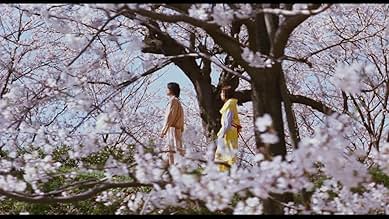ÉVALUATION IMDb
7,5/10
18 k
MA NOTE
Ajouter une intrigue dans votre langueThree stories of never-ending love.Three stories of never-ending love.Three stories of never-ending love.
- Prix
- 3 victoires et 7 nominations au total
Kyôko Fukada
- Haruna Yamaguchi, the Pop Star
- (as Kyoko Fukada)
Histoire
Le saviez-vous
- AnecdotesThis is the last Takeshi Kitano film to feature music by Joe Hisaishi. Kitano claimed that it became too expensive to hire Hisaishi for soundtracks while Hisaishi claimed that he didn't like the screenplay of the movie. Actually, they both had an argument about some pieces which weren't selected for the soundtrack, and where to put the others in the movie. They stopped working together since then.
- ConnexionsReferenced in Personne ne sait (2004)
Commentaire en vedette
"Dolls" is a gripping lesson in film as a visual medium, even when exploring territory that Beckett and Bergman handled verbally.
Takeshi Kitano wrote, directed and edited with astonishing beauty and poignancy, way beyond the audience pleasing romp of "Zatôichi: The Blind Swordsman." With minimal dialog, he is in a great partnership with the breathtaking cinematography of Katsumi Yanagishima, which uses seasonal changes as powerful visual and emotional metaphors as did "Spring, Summer, Fall, Winter... and Spring (Bom yeoreum gaeul gyeoul geurigo bom)," and the moody music of Joe Hisaishi, which effectively switches back and forth from traditional to Western instrumentation, as the film opens with a Bunraku puppet theater performance and then the stories of three casually intersecting couples gradually enact the sensibility of this what I presume is a traditional tale. The senses are so powerfully called upon that when two blinded characters stand in a rose garden I practically smelled the flowers.
While I am sure I missed a multitude of references and symbols, particularly colors, to elements of Japanese culture past and present, the very powerful themes of the spectrum of ambition destroying love such that love becomes a guilt-filled responsibility at one extreme and obsession at the other are similarly hauntingly recalled in Western culture, such as in old English ballads and more contemporary versions like "The Long Black Veil" and Springsteen's "Reason to Believe." I also felt resonances from "Waiting for Godot" to classics sensitively sympathetic to love-tossed women as "Madame Bovary" and "Anna Karenina."
Flashbacks are used powerfully in a Joycean stream of consciousness way, so that we see the memories, dreams and disturbing nightmares of the characters'associations, literally showing us the Faulknerian dictum that "The past is never dead. It's never even past." This adds considerable emotional build-up for each character as they restlessly return to geographies with meanings to their lives and we gradually see what they were like before their current emotionally (or in some cases physically) stunted states so we heartbreakingly understand their personal iconography, particularly for those two unforgettably bound beggars.
There is no Hollywood happy endings for these couples, only acceptance of the fates they have consciously and willingly chosen and committed themselves to. But their resignation is thrillingly moving in its very graphic representation.
Takeshi Kitano wrote, directed and edited with astonishing beauty and poignancy, way beyond the audience pleasing romp of "Zatôichi: The Blind Swordsman." With minimal dialog, he is in a great partnership with the breathtaking cinematography of Katsumi Yanagishima, which uses seasonal changes as powerful visual and emotional metaphors as did "Spring, Summer, Fall, Winter... and Spring (Bom yeoreum gaeul gyeoul geurigo bom)," and the moody music of Joe Hisaishi, which effectively switches back and forth from traditional to Western instrumentation, as the film opens with a Bunraku puppet theater performance and then the stories of three casually intersecting couples gradually enact the sensibility of this what I presume is a traditional tale. The senses are so powerfully called upon that when two blinded characters stand in a rose garden I practically smelled the flowers.
While I am sure I missed a multitude of references and symbols, particularly colors, to elements of Japanese culture past and present, the very powerful themes of the spectrum of ambition destroying love such that love becomes a guilt-filled responsibility at one extreme and obsession at the other are similarly hauntingly recalled in Western culture, such as in old English ballads and more contemporary versions like "The Long Black Veil" and Springsteen's "Reason to Believe." I also felt resonances from "Waiting for Godot" to classics sensitively sympathetic to love-tossed women as "Madame Bovary" and "Anna Karenina."
Flashbacks are used powerfully in a Joycean stream of consciousness way, so that we see the memories, dreams and disturbing nightmares of the characters'associations, literally showing us the Faulknerian dictum that "The past is never dead. It's never even past." This adds considerable emotional build-up for each character as they restlessly return to geographies with meanings to their lives and we gradually see what they were like before their current emotionally (or in some cases physically) stunted states so we heartbreakingly understand their personal iconography, particularly for those two unforgettably bound beggars.
There is no Hollywood happy endings for these couples, only acceptance of the fates they have consciously and willingly chosen and committed themselves to. But their resignation is thrillingly moving in its very graphic representation.
- noralee
- 16 déc. 2004
- Lien permanent
Meilleurs choix
Connectez-vous pour évaluer et surveiller les recommandations personnalisées
- How long is Dolls?Propulsé par Alexa
Détails
Box-office
- Brut – États-Unis et Canada
- 4 067 $ US
- Fin de semaine d'ouverture – États-Unis et Canada
- 2 067 $ US
- 12 déc. 2004
- Brut – à l'échelle mondiale
- 5 405 725 $ US
- Durée1 heure 54 minutes
- Couleur
- Mixage
- Rapport de forme
- 1.85 : 1
Contribuer à cette page
Suggérer une modification ou ajouter du contenu manquant
































